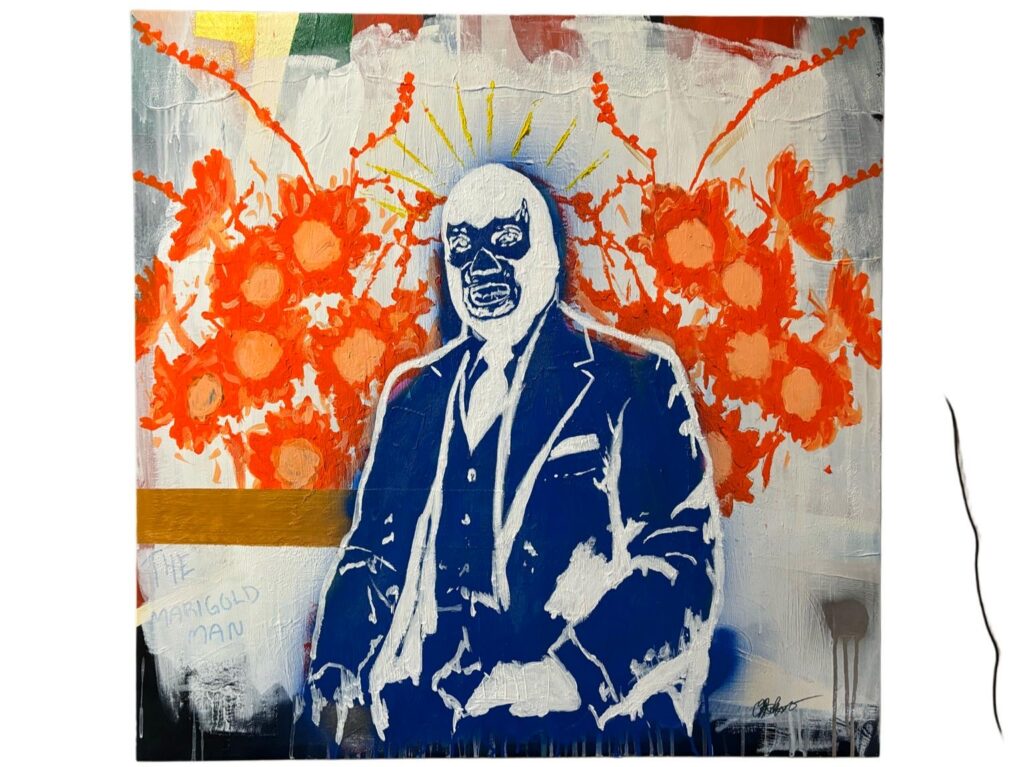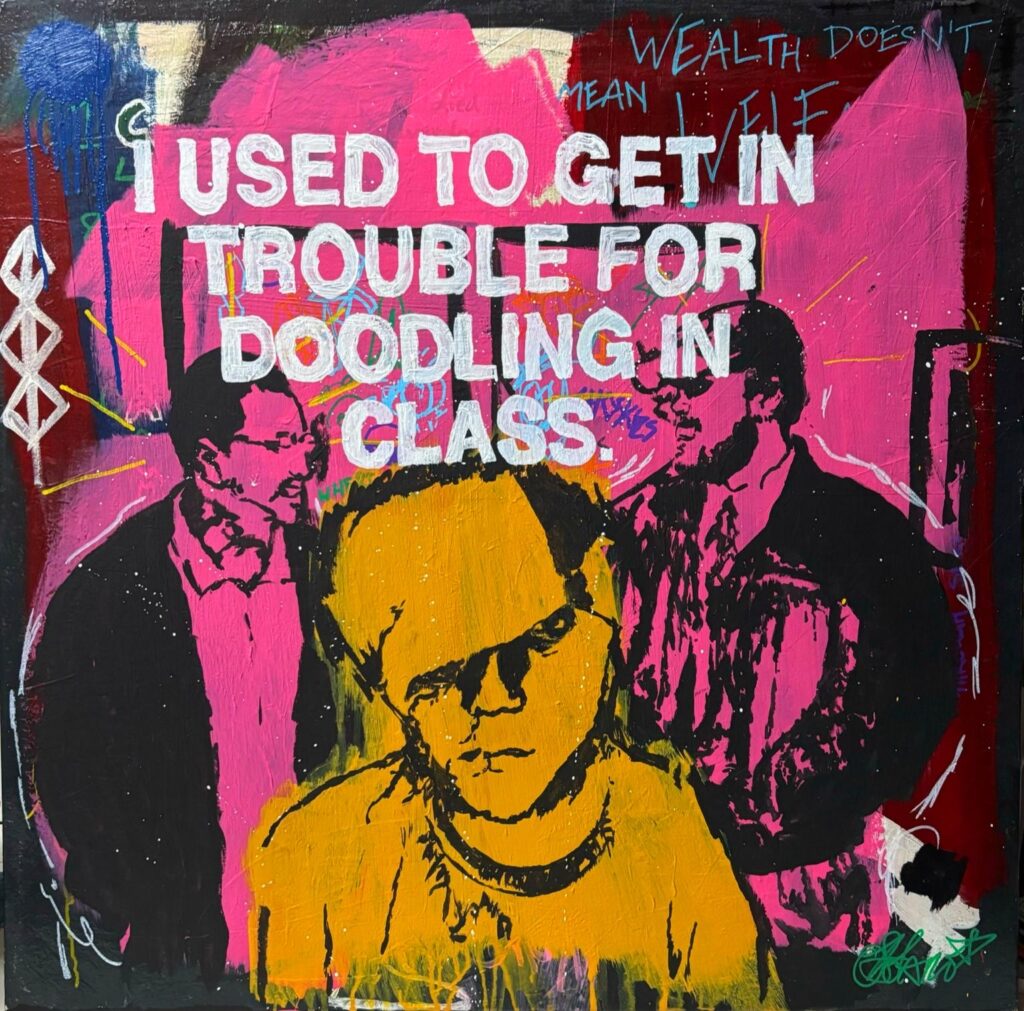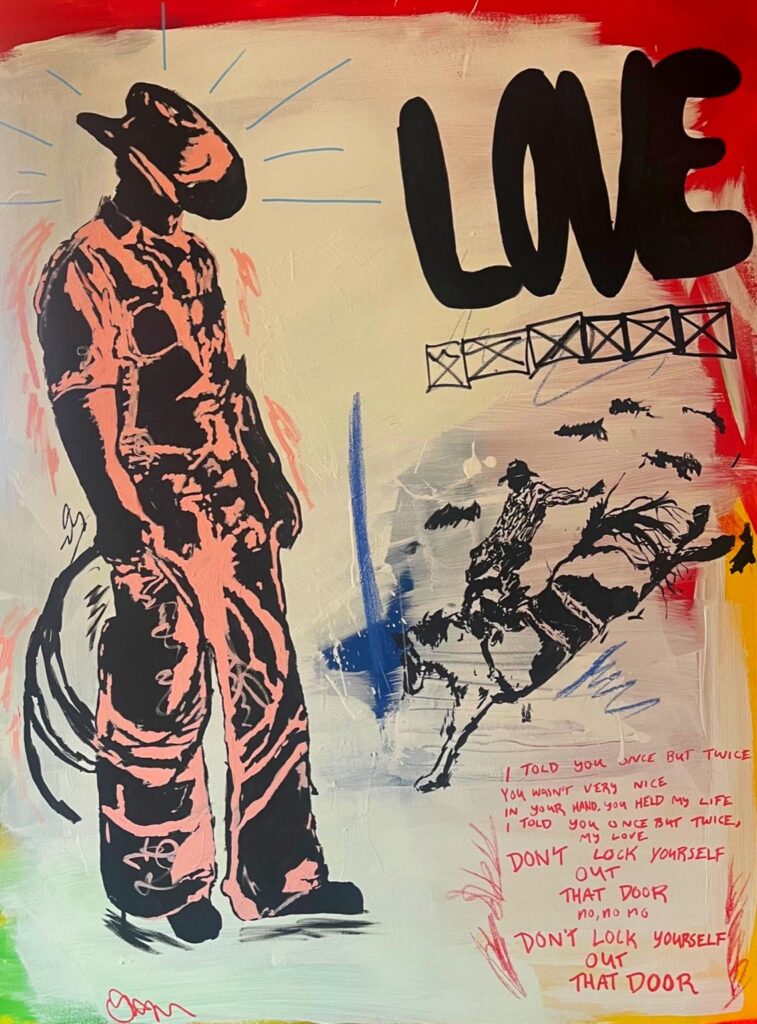Your cart is currently empty!
INTERVIEW | Oscar Solano
Art has always been intertwined with my life. When I was younger, art and escapism meant the same thing. It was to escape the mundane and cyclical nature of growing up. From distracting myself in class by doodling or dreaming of becoming rich and famous with my friends and my clothing company when we were teens. I always thought of art as a way to get where I wanted to be. Being from Palm Springs attracted me to look past the superficiality and top layer of what seems like just a resort town and look deeper. I began going to therapy about two years ago and my therapist sensed something in me that I couldn’t, they recommended I paint. I had never had any experience with painting as my art was always through graphic design or music up until that point. Since then, painting has allowed me to delve deeper, uncovering emotions and stories I hadn’t yet explored.

My art is a visual journal, a collage of my life’s experiences and complex emotions. Each piece should always feel like a diary entry, intertwined with growth and self-discovery. To me, art should be personal and layered. I often am inspired by artists of the past, I like the vibrant contrasting colors of Clyfford Still or music and movies whose lyrics or lines I will often throw onto the canvas as well. My art isn’t just a reflection of myself but a way to connect with others. In past art shows, I have found that my art creates a dialogue and shared experiences with others. Painting feels like discovering parts myself I didn’t know existed, unfolding with each layer of color, scribble, or brushstroke. Through my art, I hope to discover truth and create something real where people can see themselves or simply be comfortable with life’s truths.

1. How has your perspective on art evolved from when it was a means of escapism in your youth to becoming a visual journal of self-discovery?
My perspective on art has evolved dramatically over the years. As a child, my outlook on art was that it served as tool for external purposes rather than a medium for self-expression. It was deeply rooted in consumerism as I would say my art journey started with designing tees and sweatshirts with my friend in high school. I rarely thought about art as a way of communicating or using it as a way to emotionally connect with people. It wasn’t about what I felt it was about meeting expectations and quenching that sort of want for what customers wanted or what I thought they might like. At least for me it was like that in the beginning. It became less of “I hope others will like this.” or “what will my homies think of this?” and more of this is what I feel like making. My art now is definitely a visual journey, a reflection of my environment or myself. It’s become a way to document not just the way my art is evolving but myself as a person
2.Can you share a specific painting or moment that felt like a breakthrough in uncovering emotions during your therapeutic process?
The first painting I made professionally holds a special place in my story as an artist. To me that piece wasn’t just a painting but a pivotal moment in my life personally and professionally. I couldn’t even afford a canvas during this time but I had this old graphic poster on canvas of Cesar Chavez. By using what I had at my disposal and being resourceful it took me through the process of taking something that already exists and transforming it into a deeper reflection. I still to this day will flip canvas that I find at thrift stores. The piece itself was about heritage, a topic that was deeply personal to me. I was beginning to take art- and myself- more seriously. Exploring my identity and culture allowed to me to reconnect and heal parts of myself I ignored for so long like connecting with my roots or just thinking that the stuff that I did mattered. It wasn’t just about painting something visually appealing; it was about rediscovering and loving myself again. I sold that first painting and it just reinforced the idea that my art could be meaningful and personal yet still universal and connect with others.
3.How do the vibrant, contrasting colors of Clyfford Still, or the lyrics and lines from music and movies, shape your creative process?
I’ve always been drawn to bold, big and dynamic art, which is definitely some of the reasons I love Clyfford Still’s work. The way he utilizes striking colors and the way you can see the expressive brush strokes of his in his art makes it all feel raw yet refined and alive, which are things I like to think I bring into my own work. My style is definitely kinetic and full of movement and energy- my personal philosophy is that art needs to be bold to feel like it stands out against the everyday mundane of what life can be. To me the world can feel monotonous and uninspired at times and I want my work to erase that with injecting the world with color, energy and emotion onto the canvas. Alongside this, lyrics from songs or lines from movies play an important role in shaping the way my art formulates and takes shape. I might name a painting after the song I feel most resembles the ideas presented or write down the lines. All of these elements give my art a layer of personal narration, allowing me to connect with viewers of my art on different levels while also maintaining enough room for they themselves to come up with their own meanings

4.Are there specific songs, films, or lines that have had a particularly profound impact on your recent work?
There are several pieces of media that always float around in the back of my mind whether it’s albums by Prince or some of my favorite films I think they’re so engraved into my being that it’d be silly if I didn’t say they didn’t consistently play a role. Like I mentioned earlier I often name my artwork after songs so music is constantly an inspiration. Recently I have been diving into Greek mythology again particularly the story of Narcissus. A client requested a piece near their mirror so it was kind of perfect in sort the way it fit into my exploration of identity and how we perceive ourselves. The timelessness of myths and the sort of fable like qualities or universal themes that are included are what fascinates me the most. All of these influences allow me to layer my work with meaning and emotions, creating a bridge between my personal experiences and things other people might have consumed in media
5.Your art serves as a diary entry—how do you balance personal storytelling with creating pieces that resonate universally with others?
The key of balancing personal storytelling and creating universal resonance is in the details. My art often will explore broad ideas on masculinity, identity or culture but what makes it personal is the details I decide to include. So it might be lyrics from a song that are meaningful to me or a color that might strike a memory for me or even imagery that represents a moment in my life. My work is grounded in these details that helps make it feel like an intimate visual passage from my diary while still being broad enough for others to resonate with it. Everyone experiences emotions like happiness, sadness or even nostalgia but the reason we experience them differs. My goal in my art is to find a way to connect with the audience and bridge the gap between authenticity and personal with large broad themes
6.What does “truth” mean to you in the context of your art, and how do you strive to capture it on the canvas?
Truth, to me, means creating something that feels authentic and truly meaningful. It’s all about being honest with myself- asking if this is truly what I feel like expressing right now and why does it matter. I always strive to only paint with intention ensuring that each piece feels unique and captures the real essence of my personal thoughts, emotions or experiences. I don’t believe truth means perfection or something extremely polished; it’s more about making sure that my art reflects the vulnerability and genuineness it takes to share all these things. So if I think that leaning into the imperfections of a piece will help with the overall message I definitely will. If it feels true to me I pour everything of me onto the canvas
7.How does the dialogue your art creates with viewers influence your future pieces?
The dialogue between viewers and my art is definitely important to me. Whether its something minimal where someone might just think the painting is visually appealing or it reminds them of a personal experience or even evokes some sort of emotion from them it all just reencourages the idea that art can be a shared language between people. This feedback reinforces that my art is meaningful and I carry it with me onto my next piece. I do however remain very committed to staying true to my perspective and thus ensuring that my art remains personal to me

8.Since you began painting later in your artistic journey, what techniques or approaches have you found most impactful in expressing your layered emotions and stories?
Because I’ve had no formal training, I’ve approached art with a sense of freedom and curiosity that might have been more difficult to access within structured guidelines. Without the constraints of traditional techniques or expectations, I’ve been able to let my instincts guide me, experimenting with colors, textures, and compositions in ways that feel natural and authentic. This lack of formal instruction has allowed me to develop my own unique style that reflects my personal journey. This freedom to explore has also allowed me to embrace imperfections, which often lead to unexpected and meaningful outcomes. In a way, not having formal training has made my art feel more personal. Every technique I use is something I’ve discovered or developed on my own, which makes each piece a genuine reflection of my growth as an artist. This process has not only helped me express my layered emotions and stories but has also made my work deeply authentic
9.How do you envision your art evolving in the future? Are there new themes or mediums you’d like to explore?
I can see my art growing larger in scale and complexity. I want to explore more three-dimensional mediums like sculptures or even public pieces like murals. I think larger canvases already suite my art style and I think bigger installations are a natural progression of this. As far as themes go I think diving deeper into myself will only allow for more work to flow. To me it feels that there is still so much to unpack or even reflect on things that haven’t even happened yet. I also am interested in maybe being more explicit into my work. I tried going political but I feel so unqualified in giving my opinion but maybe in the future it’s something I’ll explore again
10.What message or feeling do you hope viewers take away from engaging with your work?
When viewers engage with my work, I want them to feel a sense of connection—whether that’s to their own experiences or to the themes I’m exploring. My hope is that my art serves as a kind of mirror, reflecting emotions, stories, or questions that resonate with people on a personal level. Ultimately, I hope my work leaves viewers with a feeling of interconnectedness. In a world that can often feel isolating or even boring, I want my art to remind people of the shared human experience
